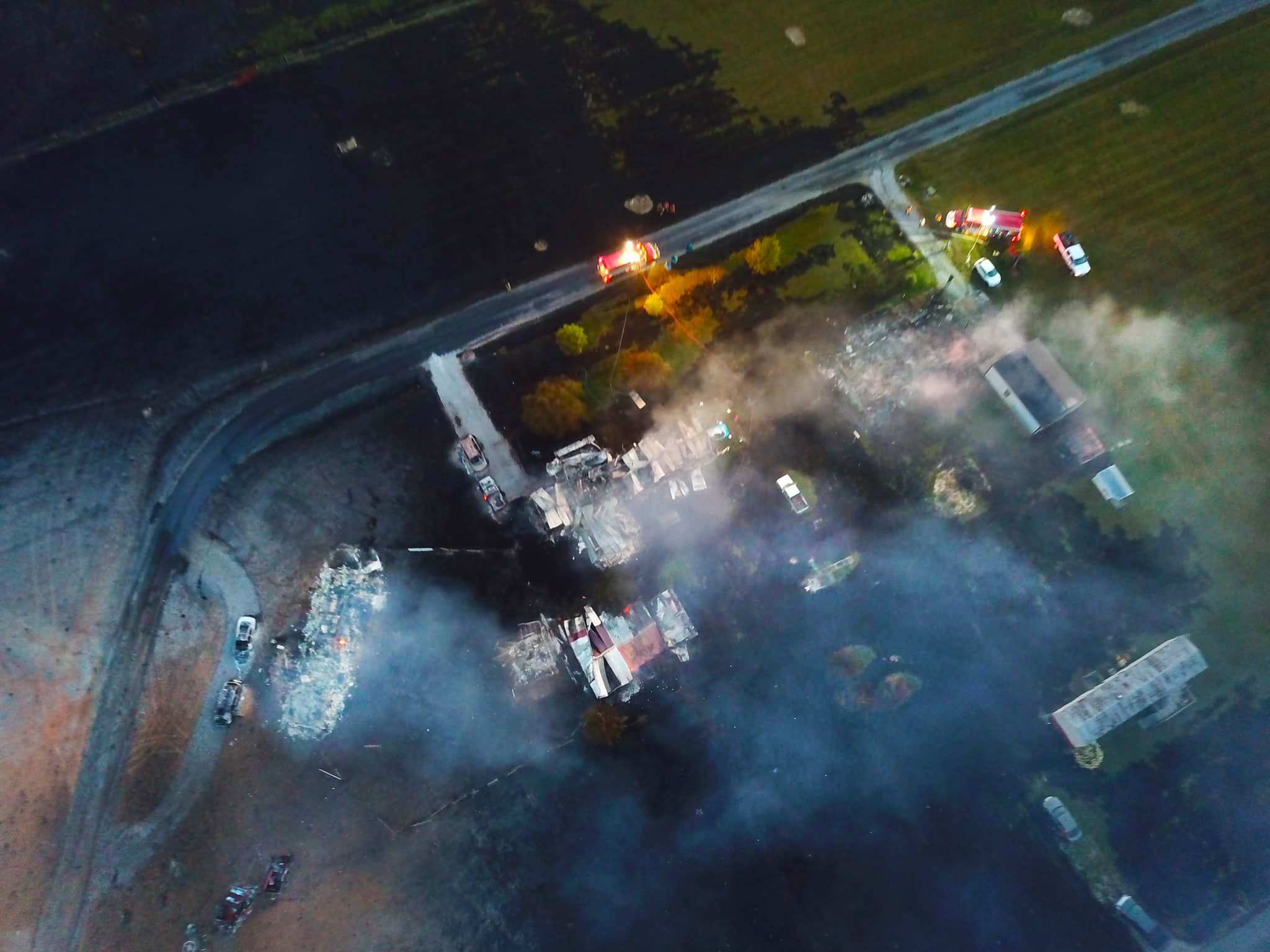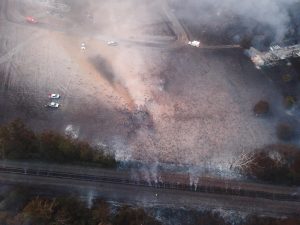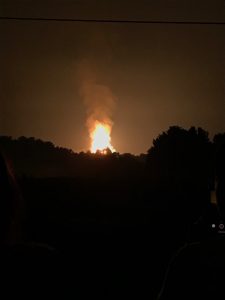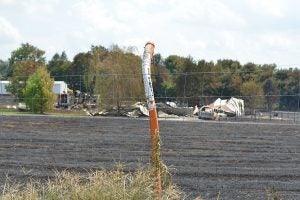Most impactful stories of 2019: Pipeline explosion rocks Moreland
Published 7:07 am Tuesday, December 24, 2019

- An aerial photograph taken by Matt Wood, a resident on Jefferies Lane, with his drone shows the extent of damage from the gas pipeline explosion in Lincoln County.
Editor’s note: This is the first of five stories chosen by The Advocate-Messenger’s staff as the most impactful of 2019.
There was no bigger breaking news in 2019 than the massive Aug. 1 pipeline explosion in the Moreland community.
The blast killed one and did extensive damage to a neighborhood in northeastern Lincoln County. Handling the fallout presented an enormous challenge for first responders, who rushed to the scene from around the region and across the state to assist.
It had far-reaching impacts.
It essentially displaced an entire neighborhood.
It brought even more attention to pipeline safety concerns that were already high in many people’s minds in Boyle County, potentially strengthening support for a decision soon after to strengthen pipeline zoning regulations.
It gave first responders a real-world stress test that let them further improve how they respond to future large-scale disasters.
Here is a recap of some of the biggest moments, from the explosion through the end of this year:
Aug. 1 — Pipeline explosion

An aerial photo taken by a drone, operated by resident Matt Wood, shows what officials mean when they say “it looks like Mars.” Wood was able to catch the after-pictures of a huge explosion caused by a natural gas pipeline in northern Lincoln County after 1 a.m. Thursday morning.
At 1:20 a.m. Aug. 1, a Texas Eastern natural gas line exploded in northeastern Lincoln County, sending an enormous fireball an estimated 300 feet into the sky; it could be seen from counties away, including Fayette, and many who live several miles from it have said they could feel the heat.
The explosion was in the Moreland area, greatly affecting the Indian Camp subdivision.
One resident — Lisa Denise Derringer, 58 — was killed in the explosion; her death is still being investigated by the Kentucky State Medical Examiner’s Office.
Several people were treated for injuries. Officials say the explosion area spans four or five acres; at least five homes were completely destroyed, but others were left virtually untouched.

A photo taken around 1:24 a.m. by Bobbie Kitchen, who was on Jeffries Lane at the time of the explosion, shows how brightly the 300-feet flames lit up the area. “We didn’t know what it was …” Kitchen said.
Thursday during a press conference, Kentucky State Police’s media liaison, Trooper Robert Purdy, said due to the area impacted by the explosion, it has been “really surprising” there were not more casualties or destroyed structures and homes, especially due to the early-morning hour it happened, when most are at home and asleep.
The natural gas pipeline is owned by Enbridge Inc. and operated by Texas Eastern Gas Pipeline Co. An incident commander with Enbridge, Jim McGuffey, said it “could take three days or could take a week” to find the answer of what made the pipeline rupture.
Officials said a resident who was leaving the scene of the incident described it as looking like Mars — the affected area has no trees or grass left, and an asphalt road in the area was turned into gravel.

A gas pipeline is bent toward where the explosion happened.(Photo by Robin Hart)
Viewing the explosion site from a field adjacent to the Indian Camp neighborhood, the entire area was black, flat and barren. Pockets of smoke were rising above the ground and several wooden fence posts were still burning. Vinyl siding on homes closest to the fire appeared to have dripped off, and burned out vehicles sat in driveways.
As a helicopter circled overhead, KSP Troopers stationed at the entrance to the neighborhood began allowing only residents into the area to secure their homes and pick up any necessary items they needed.
Earlier in the day, officials asked residents of Indian Camp to report to New Hope Baptist Church in Moreland, so that a headcount could be taken; there were still people reported missing after the explosion. Around 10:30 a.m. Thursday, everyone had been accounted for, said Trish O’Quin, deputy emergency management director for Lincoln County.
“As of right now, everything seems to be stable. We have not got any more missing people,” said Trish O’Quin, deputy emergency management director for Lincoln County.
Aug. 2: Second explosion on same pipeline
Thursday’s explosion on the Texas Eastern gas pipeline is the pipeline’s second incident this year — the same pipeline exploded in Ohio in January. A Reuters.com story says the explosion injured two people and damaged homes.
Enbridge posted update messages on its website, saying it is “continuing to respond to the incident,” and that the National Transportation Safety Board “has assumed control” of the site. “The NTSB is investigating the incident and Enbridge is supporting that investigation,” and the company has “mobilized emergency response personnel and resources to the site, and we are continuing to work alongside first responders.”
During Thursday’s noon press conference, Enbridge Incident Commander Jim McGuffey said the area contained three different pipelines, all 30 inches in diameter and located five feet below ground. He said the company’s pipelines in the area “had a sufficient amount of covering to protect them from heat.”
Aug. 3: Assessing the fallout
 Trish O’Quin sits inside the makeshift command center inside New Hope Baptist Church in Moreland. Lincoln County’s deputy Emergency Management director said organizational efforts following Thursday’s pipeline explosion in the Indian Camp community are still underway.
Trish O’Quin sits inside the makeshift command center inside New Hope Baptist Church in Moreland. Lincoln County’s deputy Emergency Management director said organizational efforts following Thursday’s pipeline explosion in the Indian Camp community are still underway.
“Mostly, the families of the area now just want to know when they’ll be allowed back in,” O’Quin said, since some houses were left standing and intact.
Thursday evening, a meeting was held at the church with the affected families and representatives from Enbridge, with the Red Cross on-hand. O’Quin said 11 prepaid $500 debit cards were handed out by the company for necessities. Enbridge is paying for an “initial three-day supply” of any needed medicines.
“They’re paying for everything right now. They stepped up and said anything financial, they will take care of at the moment,” she said.
But many are concerned about what the company will do about the long-term issues.
“Some of the (questions) they weren’t expecting were about long-term medical conditions — heat exposure, exposure to possible chemicals from burning buildings. I think that will be more of a first-responder thing, because residents of the area seemed to get out quickly.”
Aug. 3: Investigation launches
The National Transportation Safety Board’s lead investigator said Friday that Enbridge will assist by offering “technical expertise” in order for the safety board to gather information to determine what caused Thursday’s pipeline blast of Enbridge’s Texas Eastern Pipeline.

Photo by Robin Hart
The National Transportation Safety Board’s lead investigator Mike Hiller speaks to the media during a news conference Friday afternoon.
Mike Hiller led a press conference Friday, where he read from a prepared statement, explaining how the investigation is being conducted. The NTSB will not be determining a probable cause of the pipeline explosion while on the scene, he said, nor will the board “speculate” about what may have caused it.
Some good news for people affected is that Hiller thinks residents may be able to return to collect personal items from houses that weren’t destroyed, as early as Saturday morning or afternoon.
Hiller said the area of pipeline affected was installed in 1957, running from Ohio to Mississippi. At approximately 12:24 a.m. Thursday, “the pipe ruptured, releasing natural gas, ignited and burned.” He said approximately 30 feet of the pipe was ejected from the ditch.
Aug. 9: Enbridge says no health concerns
Enbridge Inc., the company that owns the Texas Eastern Pipeline that was the center of a huge explosion in Moreland last week that killed one person and injured others, says it has completed its preliminary testing at the incident site.
In a press release from Michael Barnes, a media relations and crisis communications expert with the company, he said air, soil and water sampling have been conducted off of Indian Camp Road in Lincoln County.
“The results indicate there is no risk to human health,” the release reads. When asked more specifically about the type of testing is being done in the area, and how it was determined there is no health risk, Barnes said “there are no other details to share at this moment.”
Aug. 10: Inspecting with pigs
There are several ways that Enbridge will be inspecting the pipelines. The process is called Inline Inspections, or ILI.
One way is using a large, high tech tool, called a “pig,” which is a large device to inspect the interiors of the pipelines. The pig is put inside a pipe at one of the above ground “pig launcher” sites. It can travel tens to hundreds of miles either electronically or by pressure and is called a “pig run.”
Some pigs can be used to clean out the oil and gas and push the product through pipes. But in the case of the Indian Camp area pipes in Lincoln County, the pig will have a variety of high-tech sensors, including advanced imaging technology like Magnetic Resonance Imaging (MRI) or an ultrasound similar to what’s used in the medical industry, to scan the pipeline inch by inch to collect data from the interior sides of the pipes such as indentions, rust, dips or any other anomalies.
Aug. 14: Vets groups team up for benefit
For a while, devastating pictures of the explosion aftermath in Moreland’s Indian Camp Road neighborhood were everywhere, on every news source. Five people lost their homes in the natural gas pipeline explosion on Aug. 1; one lost her life.
Now that the site has been released back to Enbridge Inc., the owners of the Texas Eastern Pipeline, after the National Transportation Safety Board concluded its onsite investigation, the news cycle has slowed as the community waits for updates.
But a group of area veterans have joined forces in order to let those families affected know they have not been forgotten, and they are not alone. “And we want to let them know we’re here for them,” said Kim Vanwinkle.
Vanwinkle is helping to organize the Community Cookout for the Pipeline Victims, which will be held Saturday at the National Guard Armory in Danville. She says the event is being put on by AMVETS 123, The American Legion Post 46 and the VFW Post 3634, all of Danville. The Armory is donating the space for the event.
“My husband is a vet …” Vanwinkle says. The posts are tight-knit groups who support each other always, she says, “and now we want to spread it out into the community.”
She says, “These families — they’ve been through something very horrific. We want to show them a little love, say ‘come out, spend the day with us, and listen to some music and eat.’”
Aug. 27: Cause remains unknown
The cause of the fatal pipeline explosion in Lincoln County has not yet been determined, according to preliminary findings released by the U.S. Pipeline and Hazardous Materials Safety Administration (PHMSA).
The findings state the possibility of damage to two more gas pipelines that run near the line that exploded cannot be ruled out.
PHMSA’s findings are included in a corrective action order issued by the agency. They show that the blast blew 30 feet of pipeline out of the ground, resulting in a crater that is 50 feet long, 35 feet wide and 13 feet deep. PHMSA says it is estimated that 66 million cubic feet of natural gas was released by the failure, with the resulting fire destroying multiple structures and burning vegetation over approximately 30 acres of land.
PHMSA says the failure happened at 1:24 a.m. Aug. 1. At 1:25 a.m., Enbridge’s Gas Control in Houston, Texas, received a rate of change alarm on Line 15, on the south side of the Danville Compressor Station. Then within minutes, public reports came in of a fire in the area. The report says a Danville Compressor Station operator also received the rate of change alarm and observed the rupture fire from the window of the compressor station control room.
During the minutes that followed, other Enbridge employees confirmed the reported fire, indicating the failure of Line 15.
Personnel at the compressor station then closed the line discharge valve, located north of the failure site. Texas Eastern field personnel responded by closing the Line 15 main block valve, then “further isolated a portion of the affected segment” and also shut down Lines 10 and 25, which it says were blocked in between the Danville Compressor Station and the Tompkinsville Compressor Station.
When the pipeline blew out of the ground, it landed approximately 460 feet from the failure site. Aside from the death of Lisa Derringer, 58, of Stanford, the explosion also resulted in the hospitalization of six people.
Firefighters from Lincoln County were the first to arrive on the scene, and approximately 75 people were evacuated from Indian Camp subdivision. Both Casey and Boyle counties’ emergency services transported some injured to Ephraim McDowell Regional Medical Center, while others were self-transported.
Findings show the failure site pipeline consists of .375-inch wall thickness, manufactured by A.O. Smith, using flash welding, and is coated with coal tar enamel, and cathodically protected with impressed current — meaning an electrical current is used to change the environment around the metal to stop corrosion.
Aug. 31: 911 calls detail panic after explosion
“Can you tell me what the hell’s going on on 127?” a man asked a 911 dispatcher in the early morning hours of Aug. 1.
The panic was evident in the voice of another man who called as he exclaimed, “I don’t know … It’s huge! Send somebody down here!”
Those two men were among the hundreds of callers filling up all lines at the Bluegrass 911 dispatch center after the gas pipeline explosion in the Indian Camp Subdivision in Moreland. The explosion of the Enbridge Texas Eastern Transmission gas line killed one person, injured six others and destroyed or damaged surrounding properties over a 30+ acre area.
Recordings of the frightening moments the morning the gas line exploded were obtained from 911. Scores of callers reported an explosion and flames lighting up the night skies — and some were just calling 911 to ask what happened.
“Yes ma’am. Something’s exploded over on 2141,” said one man. “Flames are shooting way up in the sky. It shook my whole house, ma’am.”
Multiple callers echoed that man’s call, reporting they also were “shook” by the explosion.
“It like shook our whole house and we’re miles away from it,” one man said.
“I don’t know what’s going on,” said a woman calling from VonLinger Lane. “My whole sky is lit up. The sky is all lit up and my house just shook.”
Sept. 11: Response team interviews
The Lincoln County Health Department says it sought the government’s help in investigating what possible health issues could hit the area after the Texas Eastern Pipeline explosion in Moreland.
Local and state health officials, along with a U.S. Centers for Disease Control and Prevention (CDC) team have joined forces to create a public health response team, says Diane Miller, Lincoln County’s public health coordinator. The aim of the team is to assess possible public health impacts of the natural gas pipeline explosion and the resulting fires in the vicinity of the blast.
The team will be conducting interviews with first responders who were involved, and residents living in the areas “closest to the blast site,” a release from the Cabinet for Health and Family Services states. Miller says the team will hit the ground, door-to-door, covering about a half-mile radius inside where the explosion occurred, over the next two weeks.
Oct. 25: Debriefing after the fact
The fire that occurred due to the Aug. 1 natural gas pipeline explosion in Lincoln County was so hot, the metal on vehicles liquified and dripped into metallic puddles. Heat from the inferno could be seen on the National Weather Service radar and was picked up on a satellite imagery system 26,000 miles above earth. People also reported seeing the orange glow from the explosion at the Tennessee-Kentucky border.
These were just a few observations that Lincoln County Director Emergency Services Don Gilliam and Deputy Director Trish O’Quinn shared with members of Boyle County’s Local Emergency Planning Committee on Thursday.
“I’d love to tell you everything went great, but we were overwhelmed and we made mistakes. What’s our goal? Learn from our mistakes and quit making them over,” Gilliam said.
Gilliam and O’Quinn shared a video presentation with audio recorded during the first few minutes of the explosion and aftermath and discussed what they learned from the experience.
Gilliam said it took Enbridge (the company that owns the pipeline) about an hour and a half to respond to the event and shut off the natural gas. “We discussed that with them. Could that be quicker?” Gilliam asked. “They’re looking into remote locks or valves so that they don’t have to respond. They can do it from the transmission facility, which would be awesome,” Gilliam said.
“And I’m certainly sure that’s pretty expensive so I don’t know if that will happen.”
A total of 268 responders and support responders representing 36 agencies from six counties, seven cities, three state and two federal agencies, 10 private agencies and 18 media outlets (local and national) descended on the area in and around the Indian Camp neighborhood in Moreland that early August morning, Gilliam said.
“What we learned, in summary: The worst thing about rural response is you just don’t have enough resources. You don’t have enough manpower. You don’t have enough equipment because you don’t have enough money,” Gilliam said.
“The best thing about rural response was mutual aid and good neighbors. Everyone comes to help and are willing.
“You guys that were there, thank you so much. … A lot of incidents like this, you show up on the county line and it’s not your county. Nobody would have blamed you if you turned around and went back. But you didn’t and thank you for that.”
Nov. 30: Enbridge gives Boyle first responders $45,000
Enbridge has given $45,000 to Boyle County emergency response agencies for the services they provided following the Aug. 1 pipeline explosion in Moreland.
Boyle County Judge-Executive Howard Hunt allocated $10,000 of the $45,000 to the sheriff’s office. Boyle County EMS and Boyle County Emergency Management also received $10,000 each; the Boyle County Fire Department received $15,000.






